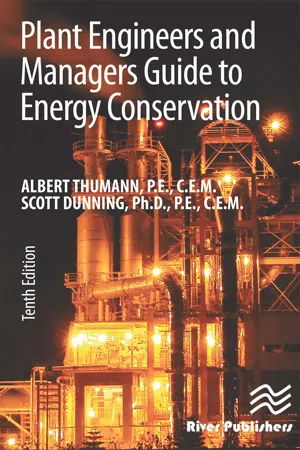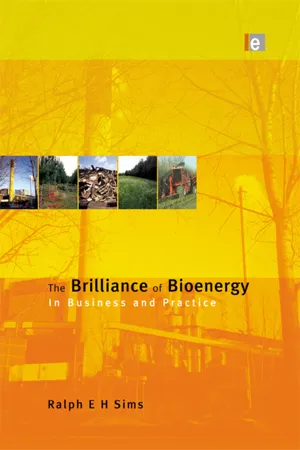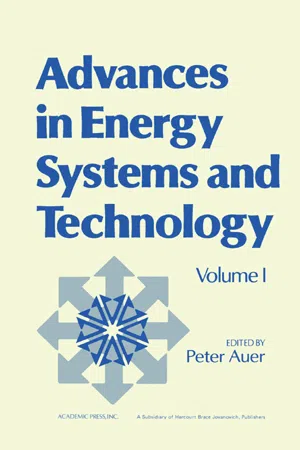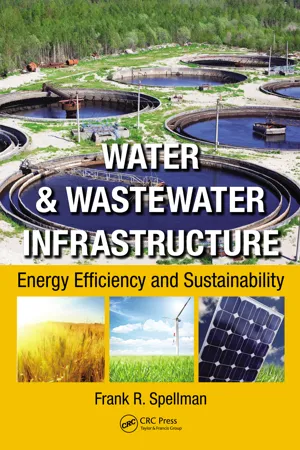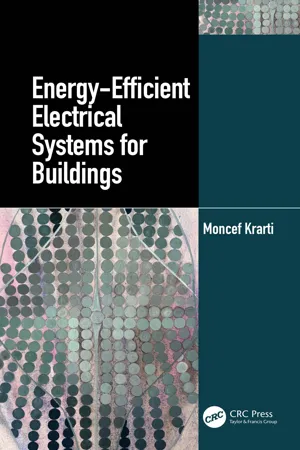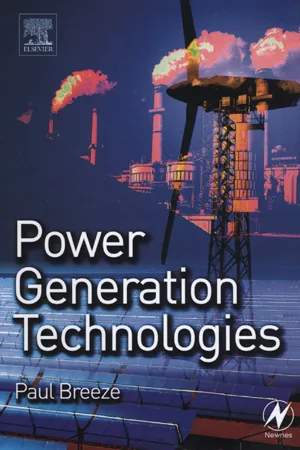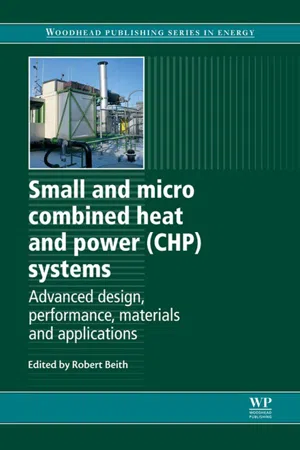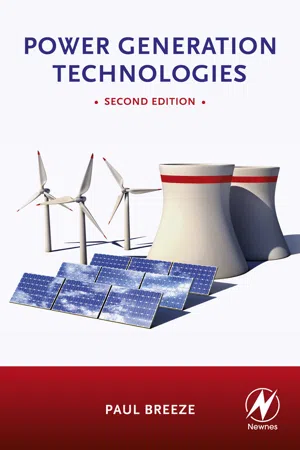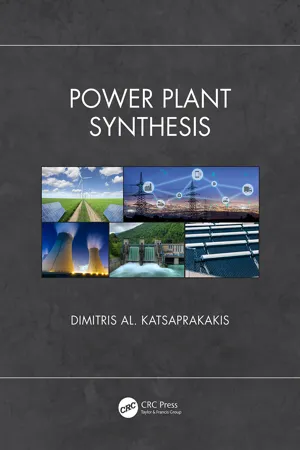Technology & Engineering
Cogeneration
Cogeneration, also known as combined heat and power (CHP), is a process where a single fuel source is used to generate both electricity and useful heat. This efficient method reduces energy waste by utilizing the heat that is typically lost in conventional power generation. Cogeneration systems are commonly used in industrial and commercial settings to improve energy efficiency and reduce environmental impact.
Written by Perlego with AI-assistance
Related key terms
Related key terms
1 of 4
Related key terms
1 of 3
12 Key excerpts on "Cogeneration"
- Albert Thumann, Scott C. Dunning(Authors)
- 2020(Publication Date)
- River Publishers(Publisher)
9Cogeneration: Theory and Practice
Because of its enormous potential, it is important to understand and apply Cogeneration theory. In the overall context of energy management theory, Cogeneration is just another form of the conservation process. However, because of its potential for practical application to new or existing systems, it has carved a niche that may be second to no other conservation technology.This chapter is dedicated to development of a sound basis of current theory and practice of Cogeneration technology. It is the blend of theory and practice, or praxis, of Cogeneration that will form the basis of the most workable conservation technology in the coming years.DEFINITION OF “Cogeneration” OR COMBINED HEAT AND POWER (CHP)
Cogeneration is the sequential production of thermal and electric energy from a single fuel source. In the Cogeneration process, heat is recovered that would normally be lost in the production of one form of energy. That heat is then used to generate the second form of energy. For example, take a situation in which an engine drives a generator that produces electricity: With Cogeneration, heat would be recovered from the engine exhaust and/or coolant, and that heat would be used to produce, say, hot water. It is this combination of heat and power which leads to the name CHP.Making use of waste heat is what differentiates Cogeneration facilities from central station electric power generation. The overall fuel utilization efficiency of Cogeneration plants is typically 70-80% versus 35-40% for utility power plants.- Asif Syed(Author)
- 2012(Publication Date)
- Wiley(Publisher)
CHAPTER 11
Cogeneration
Cogeneration IS ALSO REFERRED TO AS COMBINED HEAT AND power generation (CHP). Cogeneration is the process of simultaneously generating two forms of energy: electrical power and heat. In standard power generation, electrical energy is used, but heat is wasted by exhausting it through the stack. Cogeneration recovers the heat energy that would have been lost and puts it to use. The heat energy can be used in several ways, including space heating in winter, absorption cooling or air conditioning in summer, and domestic hot water use year-round. Another unique feature of Cogeneration is that it is localized, or located at the point of use of energy. Cogeneration produces electrical power and heat at the consumer’s site, avoiding the purchase of electricity from a utility company. Electrical generation with fossil fuel is normally done via gas boilers, which burn to produce heat; the heat produces steam to drive the turbines, which in turn power the generators, producing electricity. Another form of electrical power generation with fossil fuels uses direct-fired equipment such as gas turbines and internal combustion engines. Fossil fuel is burned directly in the engine or turbine, which powers the generators, producing electricity. In both turbines and internal combustion engines, heat energy is converted into electrical energy. The process of conversion of heat energy to electrical energy is only 30 to 40 percent efficient; 60 to 70 percent of the heat is released to the atmosphere via a flue stack or cooling tower. Of all the energy produced in the United States, 63.9 percent is lost in the conversion process;1 or, two-thirds of the fuel used to generate power is lost as heat.Figure 11-1 Conventional power plant efficiency.Asif SyedThe location of the plant where power is generated is important, if the waste heat has to be captured and used. Most large industrial power plants are located far from population centers or industrial centers, in areas where waste heat cannot be put to use. The locations of power plants are generally determined by the availability and transportation of fuel. In some instances, power plants located near population centers and industrial centers do capture and use the waste heat. In New York City, waste heat from a power plant is used to generate high-pressure steam, which is distributed via a piping network to buildings in Manhattan. This steam is used for heating and cooling the buildings: In winter, steam is used for heating, after its pressure is adjusted in pressure-reducing valves; it can generate hot water or be used directly in radiators. In summer, high-pressure steam is used in steam turbine–driven chillers or absorption chillers. In the Middle East, cities such as Dubai, Kuwait, and Jeddah use the waste heat from power plants to produce desalinated water. However, in most power plants in the United States and in other parts of the world, waste heat is not recovered. The average site-to-source energy ratio is 3.6—that is, about 3.6 units of fossil fuel energy are consumed for every 1 unit of electrical energy delivered to the site or building.- eBook - ePub
The Brilliance of Bioenergy
In Business and In Practice
- Ralph E H Sims(Author)
- 2013(Publication Date)
- Routledge(Publisher)
Chapter 8 Cogeneration of combined heat and powerWhen biomass (or coal, oil or natural gas for that matter) is used as a fuel in a conversion plant to generate electricity, some heat is always produced. This relates to the laws of energy (thermodynamics), as covered in Chapter 1 , and is unavoidable. However, if this heat can be usefully used and not ‘wasted’, as it normally is in traditional thermal power generation plants, then the overall system efficiency will be greatly improved. To be classed as ‘Cogeneration’ the by-product heat must be put to good use in some way, normally as process heat in a nearby processing plant (Figure 8.1 ). Producing steam that only drives a condensing turbine (where the waste steam is condensed and the heat rejected into the environment) is not Cogeneration.In Europe Cogeneration is also known as CHP or combined heat and power . ‘Power’ is normally assumed to be the generation of electricity, but it can also be used to describe work by a rotating shaft to drive a pump, compressor or other mechanical process machine.So a definition of Cogeneration is:The generation of two energy products from a single fuel, usually being a combination of useful heat and electricity .Figure 8.1 Cogeneration is the production of both electricity and useful heatLarge and small Cogeneration applications provide heat (usually in the form of steam) and electricity for use in activities such as mineral processing or the manufacture of pulp and paper, petrochemicals, food and textiles, as well as in hospitals, hotels, office complexes, commercial buildings and swimming pools. A range of fuels can be used for Cogeneration including biomass in the form of rice husks, straw and methane from landfill sites and biogas plants. A key growth area for Cogeneration around the world is the increasing utilization of such biomass waste products.Many successful examples of bioenergy Cogeneration plants exist in Scandinavia, North America, Australasia and elsewhere. The global trend towards privatization of the power industry has created business opportunities for the owners of biomass material to set up new business ventures by becoming independent power producers (IPP). This is normally best achieved by the resource owner’s partnering with a utility company and a third-party joint venture investor rather than trying suddenly to gain expertise in a totally new business area. A sugar company best knows how to produce sugar, not how to produce and market power! Sugar companies owning bagasse, farmers owning chicken litter, forestry companies owning wood residues and city councils owning MSW are all able to utilize their resource for generating heat and power, not only for use on-site but also for export to the grid or to neighbouring industry or dwellings. - eBook - ePub
- Peter Auer(Author)
- 2013(Publication Date)
- Academic Press(Publisher)
Government leaders and the public have recently become aware that more than half of the fuel energy consumed in American public utility electric generating plants is dissipated in water-cooled steam condensers. Construction of new plants could result in doubling the amount of energy now wasted in this way within 25 years. As a result of this awareness, the word “Cogeneration” has become popular. It refers to systems in which both electricity and heat are supplied for productive use, by the same generating unit, and the discharge of waste heat is reduced or eliminated.Cogeneration has been applied successfully in American industrial plants, but its use by all but a few public utilities, to supply district steam, is negligible, and continues to decline. By contrast, combined heat and power (CHP) generation by public utilities is a large, successful, expanding enterprise in many European countries. It supplies district heat (DH) service by means of circulating hot water, along with electric service.Development of feasible CHP/DH technologies for the United States is highly worthwhile. Fuel utilization efficiencies up to 80% are achievable, compared to 39% for electric generation alone, and thermal discharges into waterways are reduced or eliminated. In addition, the substitution of central stations for many small, inefficient individual heating plants with low chimneys adds to fuel economy and minimizes air pollution. Other advantages are: conversion to coal is facilitated by the reduced emissions from low chimneys, truck delivery of fuel oil is reduced, space is saved in buildings, maintenance and operating costs of buildings and fire hazards are reduced, service reliability is improved, and heat storage may be used to reduce utility peaks. The need for new transmission lines from remote sites is reduced, helping to preserve the countryside.Steam-electric plants in the United States operate on a system utilizing condensing turbines. These are designed to maximize conversion of fuel energy to electricity. At the temperatures used in modern steam generation, the theoretical thermodynamic efficiency achievable is about 40%. A few existing units operate at nearly 39% efficiency, but the typical efficiency of American fossil-fueled plants is about 33%, corresponding to a heat rate of 10,000 Btu/kW h. - eBook - ePub
Water & Wastewater Infrastructure
Energy Efficiency and Sustainability
- Frank R. Spellman(Author)
- 2013(Publication Date)
- CRC Press(Publisher)
Section III Energy-Efficient Technology Another world is not only possible, she is on her way. On a quiet day, I can hear her breathing.— Arundhati RoyPassage contains an image
7
Combined Heat and Power (CHP)By installing a CHP system designed to meet the thermal and electrical base loads of a facility, CHP can increase operational efficiency and decrease energy costs, while reducing emissions of greenhouse gases that contribute to the risks of climate change.—USEPA Combined Heat and Power PartnershipThe first rule of sustainability is to align with natural forces, or at least not try to defy them.—Paul Hawken, Environmentalist7.1 Introduction*
Combined heat and power (CHP), also known as Cogeneration, is an efficient, clean, and reliable approach to generating power and thermal energy from a single fuel source. Basically, CHP is the simultaneous production of electricity and heat from a single fuel source, such as natural gas, biomass, biogas, coal, or oil. Wastewater treatment plants that have anaerobic digesters create methane gas as a byproduct of digestion of biosolids. Currently, a number of these plants release methane gas by flaring, converting methane to CO2 and releasing it into the environment. Methane gas, however, is a good source of energy. By installing a CHP system designed to meet the thermal and electrical base loads of the plant, CHP can greatly increase the plant’s operational efficiency and decrease energy costs. At the same time, CHP reduces the emission of greenhouse gases, which some feel may contribute to global climate change.The plant’s ability to produce its own electricity onsite has significant advantages. CHP systems have economical and environmental benefits; for example, they can reduce energy costs, offset capital costs, protect revenue streams, hedge against volatile energy prices, and reduce reliance on outside energy sources. CHP is not a single technology, but an energy system that can be modified depending on the needs of the energy end user. CHP systems consist of a number of individual components configured into an integrated whole. These components include the prime mover, generator, heat recovery equipment, and electrical interconnections. The prime mover that drives the overall system typically indentifies the CHP system. Prime movers for CHP systems include turbines, microturbines, internal combustion/reciprocating engines, steam engines/turbines, and fuel cells (USEPA, 2008 - Moncef Krarti(Author)
- 2023(Publication Date)
- CRC Press(Publisher)
Offshore turbine 168.6 22.5 0.0 196.9 38 Solar Solar thermal (CSP) 191.6 42.1 0.0 239.7 20 Photovoltaic (PV) 109.8 11.4 0.0 125.3 25 Geothermal Dual flash 34.1 12.3 0.0 47.8 92 Hydroelectric With seasonal storage 70.7 3.9 7.0 83.5 54Source: EIA, Updated capital cost estimates for utility scale electricity generating plants, Energy Information Agency, Department of Energy, Washington, DC, http://www.eia.gov/forecasts/capitalcost/pdf/updated_capcost.pdf , 2013.In this chapter, only dispatchable generation technologies are presented with a focus on CHP systems to provide both electricity and thermal energy to buildings. First, the basic advantages of Cogeneration systems are outlined with some brief outline of their history. Then, a detailed description is provided for technologies that can be used to generate power for building applications. An analysis including an estimation of the optimal capacity of Cogeneration systems is presented with specific case studies. The integration of renewable energy to design net zero-energy buildings and carbon-neutral communities is discussed in Chapter 14 .13.2 Benefits of Cogeneration
Cogeneration and combined heat and power (CHP) are terms used interchangeably to denote the simultaneous generation of power (electricity) and usable thermal energy (heat) in a single, integrated system. A CHP plant derives its efficiency, and hence lower costs, by recovering and utilizing the heat produced as a by-product of the electricity generation process that would normally be wasted in the environment. The overall fuel efficiency of typical CHP installations can be in the range of 70%–90%, compared with 35%–50% for conventional electricity generation. Overall, CHP achieves a 35% reduction in primary energy usage compared with remote power stations and heat-only boilers. Moreover, CHP also avoids transmission and distribution losses since it supplies electricity generally close to the generation site.- eBook - ePub
- Paul Breeze(Author)
- 2005(Publication Date)
- Newnes(Publisher)
5Combined heat and power
Publisher Summary
This chapter explains the concept of combined heat and power (CHP), various CHP technologies, and the related environmental considerations. Low-grade heat can be used to produce hot water or for space heating while higher-grade heat will generate steam, which can be exploited by some industrial processes. In this way, the waste heat from power generation can replace the heat or steam produced from a high-grade energy source such as gas, oil, or even electricity. Systems that utilize waste heat in this way are called CHP systems. Such systems can operate with an energy efficiency of up to 90%. This represents a major saving in fuel cost and in environmental degradation. Yet, while the benefits are widely recognized, the implementation of CHP remains low. Most types of power generation technology are capable of being integrated into a CHP system; however, there are obvious exceptions such as hydropower, wind power, and solar photovoltaic. Fuel cells are probably one of the best CHP sources while conventional technologies such as steam turbines, gas turbines, and piston engine plants can all be easily adapted. The primary environmental impact associated with a CHP plant will be a function of the technology employed in the plant. Atmospheric emissions will vary, depending on whether the plant employs a diesel engine, a gas turbine, a steam turbine with a biomass boiler, or a nuclear reactor as the energy conversion system.The production of electricity from fossil, biomass or nuclear fuels is an inefficient process. While some modern plants can achieve nearly 60% energy conversion efficiency, most operate closer to 30% and smaller or older units may reach only 20%. The USA, which has a typical mix of fossil-fuel-based combustion plants, achieves an average power plant efficiency of 33%. Other countries would probably struggle to reach even this level of efficiency. - eBook - ePub
Current Trends and Future Developments on (Bio-) Membranes
Cogeneration Systems and Membrane Technology
- Angelo Basile, Giuseppe Spazzafumo(Authors)
- 2020(Publication Date)
- Elsevier(Publisher)
Chapter 1Cogeneration plants for district heating (and cooling)
Stefano Campanari and Nicola Fergnani, Department of Energy, Politecnico di Milano, Milano, ItalyAbstract
This chapter introduces the concept of heat and power Cogeneration for district heating and cooling applications. The first section is dedicated to the definition of thermodynamic concepts and performance indexes for Cogeneration plants. The discussion then focuses on the main technologies adopted for the prime mover (including gas turbines, steam cycles, combined cycles, internal combustion engines, and fuel cells), from the point of view of plant layout and operating principles; the technology of absorption chillers for cooling applications is also introduced. Finally, the main features of district heating and cooling networks are briefly discussed.Keywords
DHC; CHP; Cogeneration; district heating and cooling; CCHP; primary energy savings1.1 Introduction
Cogeneration (CHP: combined heat and power) is defined as the conversion of the chemical energy of a fuel, such as natural gas, into thermal and electrical (or mechanical) energy in a unique process (Fig. 1.1 ). The “prime mover” of a CHP process is a generic system or machine capable of generating electricity and heat; it can be a combustion-based system (e.g., internal combustion engine, gas turbine, steam cycle) or a fuel cell, a generic machine using a fuel or another type of heat source (including renewable sources) as the primary energy input. If a share of the heat or electricity production is used to generate cooling, the entire process is called trigeneration (CCHP: combined cooling, heating, and power).Figure 1.1 - eBook - ePub
Small and Micro Combined Heat and Power (CHP) Systems
Advanced Design, Performance, Materials and Applications
- R Beith(Author)
- 2011(Publication Date)
- Woodhead Publishing(Publisher)
Part I Introduction to small and micro combined heat and power (CHP) systemsPassage contains an image 1
Overview of small and micro combined heat and power (CHP) systems
J. Knowles, Barbreck Services, UKAbstract:
Though considered a modern energy efficient technology, combined heat and power (CHP) has its genesis in the factories of the industrial revolution during the late nineteenth century. It lost its place in industry to central electricity generation and national grids, but through the latter part of the last century, with the development of reliable prime movers and the advent of microprocessor-based controls, resurgence has taken place. Now, at the start of the twenty-first century, a combination of ever increasing energy use and the growing realisation of the damage done to our environment is demanding ever more innovative and efficient technologies. CHP is adopting these new technologies and applying microturbines, Stirling engines and fuel cells alongside the latest developments in more conventional systems.Key words Cogeneration CHP combined heat and power energy efficiency history power electricity generation1.1 Introduction to Cogeneration - a short history
It is not difficult to identify the genesis of CHP, except that the term combined heat and power would never have been uttered as the nineteenth century drew to a close. The industrial revolution brought about the mechanisation of manufacture across the whole spectrum of industry. It was driven by energy derived principally from the combustion of coal to generate steam which was converted into mechanical power in a steam engine. In a late nineteenth-century factory, this power would be transmitted via a system of shafts and pulleys to a variety of machines. A relatively small inventive step by the Victorian engineers recognised that the waste heat from power generation could be used within the factory to provide heating in winter, and in some cases to facilitate manufacturing processes. - eBook - ePub
- Paul Breeze(Author)
- 2014(Publication Date)
- Newnes(Publisher)
Chapter 6Combined Heat and Power
Abstract
All combustion power plants operate inefficiently, with much of the fuel energy going to waste as heat. This heat can be exploited in a variety of ways, raising the overall efficiency of the power plant. Heat is used for district heating in some US and European cities but this has not proved widely popular. Some industries can also make use of steam for their processes. Wood and paper processing factories will often have their own power plant that supplies both heat and electricity. Combined heat and power plants are most effective when both electricity and heat are supplied to the same customers. Many types of power generation plant can be used for combined heat and power but coal-fired boilers, gas turbines and piston engine-based systems are the most common. Fuel cells can also be exploited. Sizing a combined heat and power plant correctly is the key to economic viability.Keywords combined heat and power CHP Cogeneration district heating process heat steam generation gas turbine micro-turbine fuel cellThe production of electricity from coal, oil, gas, and biomass is an inefficient process. While some modern combustion plants can achieve 60% energy conversion efficiency, most operate closer to 30%, and smaller or older units may reach only 20%. The United States, which has a typical developed-world mix of fossil fuel–based combustion plants, achieves an average power plant efficiency of 33%, a level that has barely shifted for the past 30 years. Other countries would probably struggle to reach even this level of efficiency.Put another way, between 40% and more than 80% of all the energy released during combustion in power plants is wasted. The wasted energy emerges as heat that is dumped in one way or another. Sometimes it ends up in cooling water that has passed through a power plant and then returned to a river or the sea, but most often it is dissipated into the atmosphere through some form of air–heat exchanger. This heat can be considered a form of pollution. - eBook - ePub
- B. K. Hodge(Author)
- 2017(Publication Date)
- Wiley(Publisher)
11 Combined Heat and Power Systems 11.1 Introduction Combined heat and power (CHP) systems are characterized by the decentralized generation of electricity by a prime mover and the capture and use of reject thermal energy from the prime mover. The advantages for CHP systems are simple: increased overall system thermal efficiency, enhanced power quality, improved energy resiliency, and decreased greenhouse and other gases emissions. The electrical grid is based on large, centrally located power plants. The transmission of power from such plants to the end users is accomplished through an electrical grid that consists of high-voltage transmission systems and low-voltage distribution systems. The high-voltage transmission system carries electricity from the power plants and transmits it to substations, where the high-voltage electricity is transformed into low voltages and distributed to individual customers. The overall thermal efficiency of generation, transmission, and distribution is relatively low. Figures 11.1 and 11.2 illustrate the losses inherent to the generation and delivery of electric power in both traditional and combined-cycle power plants. Termuehler (2001) presents a lucid history of power plant developments, and Kehlhofer et al. (1999) discuss in detail combined-cycle power plants. Traditional power plants convert about >30% of the available energy of the fuel into end-user electric power, and highly efficient, combined-cycle power plants convert about 50% of the available energy into end-user electric power. The majority of the energy content of the fuel is lost at the power plant through the discharge or rejection of waste heat - eBook - ePub
- Dimitris Al. Katsaprakakis(Author)
- 2020(Publication Date)
- CRC Press(Publisher)
In such types of applications, the electricity production efficiency ranges between 5%–15%. It is underlined, yet, that electricity production constitutes an additional product, based on the achieved heat recovery, which otherwise would have been disposed in the ambient. Consequently, even with this considerably low efficiency, electricity production can be feasible in such types of Cogeneration systems.
There are two basic types of CHP configurations with gas turbines, the open and closed type CHP systems. The consumed fuel is usually natural gas, liquefied petroleum gas (LPG), or diesel oil.5.3.2 Gas Turbine Cogeneration Systems5.3.2.1 Cogeneration Systems with Open-Cycle Gas TurbinesOpen-cycle gas turbines are the conventional gas turbines presented in Chapter 2 . Air is suctioned from the ambient, compressed, and led to the combustion chamber. The produced hot gases after the ignition of fuel and the combustion of the fuel-air mixture are expanded, releasing power which is captured in the form of mechanical work by the turbine. The remaining hot gases are eventually disposed in the atmosphere with a temperature that can range from 300° C to 600° C.The disposed heat exploitation from an open-cycle gas turbine in a Cogeneration system can be approached with two alternative ways:- With its direct uses in thermal processes (district heating, industrial thermal processes, etc.).
- By supplying it to heat recovery units, named heat recovery boilers or simply gas boilers. High enthalpy steam is then produced in these gas boilers, appropriate for various production processes, like thermal processes, or also to drive a steam turbine for additional electricity production. This last implementation is the classic case of a combined cycle for electricity production, presented thoroughly in Chapter 2 .
In the above mentioned systems, there is the possibility to increase the hot gases’ specific enthalpy, and, subsequently, the delivered thermal energy, due to their high oxygen content. This is achieved by inserting a combustion chamber between the gas turbine and the heat recovery boiler, where, with the consumption of additional fuel, the capturing process of the contained oxygen is integrated, creating improved combustion conditions and increasing the system’s overall efficiency (Figure 5.8
Index pages curate the most relevant extracts from our library of academic textbooks. They’ve been created using an in-house natural language model (NLM), each adding context and meaning to key research topics.
Explore more topic indexes
Explore more topic indexes
1 of 6
Explore more topic indexes
1 of 4
